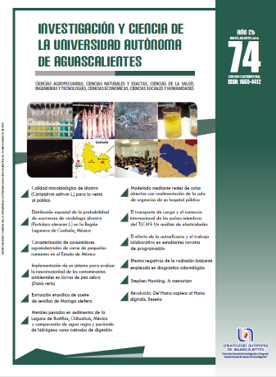Spatial distribution of the probability of occurrence of wild purslane (Portulaca oleracea L.) in the Region Lagunera of Coahuila, Mexico
DOI:
https://doi.org/10.33064/iycuaa2018741716Keywords:
spatial distribution, Kriging interpolation, land classes, logistic regression, Portulaca oleraceaAbstract
The interest in introducing purslane (Portulaca oleracea L.) as a cultivable plant has been increased by its medicinal properties. However, studies of its spatial distribution and relation to the type of soil are scarce. The objectives of this work were to determine the probability of occurrence of purslane, and the relationship between its spatial distribution and the edaphic characteristics in the Region Lagunera. The presence/absence data of purslane and surface soil samples of sites in different land classes were obtained, and determined the physical and chemical characteristics of the soils. The data obtained were used to estimate the probability of occurrence of purslane with a logistic regression and were mapped. The results show that the sand, electrical conductivity and pH influence the presence of the purslane, being its spatial distribution different,
Downloads
References
• Alam, M. A., Juraimi, A. S., Rafi, M. Y., Hamid, A. A., Aslani, F. & Alam, M. Z. (2015). Effects of salinity and salinity-induced augmented bioactive compounds in purslane (Portulaca oleracea L.) for possible economical use. Food Chemistry, 169, 439-447.
• Barrera-Bassols, N., Zinck, J. A., & Van Ranst, E. (2006). Local soil classification and comparison of indigenous and technical soil maps in Mesoamerican community using spatial analysis. Geoderma, 135, 140-162.
• Blázquez, M. A., & Carbó, E. (2015). Control of Portulaca oleracea by boldo and lemon essential oils in different soils. Industrial Crops and Products, 76, 515-521.
• Brady, N. C., & Weil, R. R. (2008). The nature and properties of soils. (14th. ed.). Upper Saddle River, NJ, US: Pearson-Prentice Hall.
• Cruz-Cárdenas, G., Ortiz-Solorio, C. A., Ojeda-Trejo, E., Martínez-Montoya, J. F., Sotelo-Ruiz, E. D., & Licona-Vargas, A. L. (2010). Evaluation of four digital classifiers for automated cartography of local soil classes based on reflectance and elevation in Mexico. International Journal of Remote Sensing, 31(3), 665-679.
• García, E. (2004). Modificaciones al sistema de clasificación climática de Köppen. D. F., México: Universidad Nacional Autónoma de México.
• IUSS Working Group WRB. (2015). World Reference Base for Soil Resources 2014: International soil classification system for naming soils and creating legends for soil maps. World Soil Resources Reports No. 106. Rome, Italy: FAO.
• Kafi, M., & Rahimi, Z. (2011). Effect of salinity and silicon on root characteristics, growth, water status, proline content and ion accumulation of purslane (Portulaca oleracea L.). Soil Science and Plant Nutrition, 57(2), 341-347.
• Licona-Vargas, A. L., Ortiz-Solorio, C. A., Gutiérrez-Castorena, M. C., & Manzo-Ramos, F. (2006). Clasificación local de tierras y tecnología del policultivo café-plátano para velillo-sombra en comunidades cafetaleras. Terra Latinoamericana, 24(1), 1-7.
• Liu, L., Howe, P., Zhou, Y. F., Xu, Z. Q., Hocart, C., & Zhan, R. (2000). Fatty acids and beta-carotene in australian purslane (Portulaca oleracea) varieties. Journal of Chromatography A, 893(1), 207-213.
• Mera-Ovando, L. M., Bye-Boettler, A., & Solano, M. L. (2014). La verdolaga (Portulaca oleracea L.). Fuente natural de Omega 3 y Omega 6. Agroproductividad, 7(1), 3-7.
• Ortiz-Solorio, C. A., & Gutiérrez-Castorena, M. C. (1999). Evaluación taxonómica de sistemas locales de clasificación de tierras. Terra Latinoamericana, 17(4), 277-286.
• __________ (2001). La etnoedafología en México, una visión retrospectiva. Etnobiología, 1(1), 44-62.
• Ortiz-Solorio, C. A., Gutiérrez-Castorena, M. C., Licona-Vargas, A. L., & Sánchez-Guzmán, P. (2005). Contemporary influence of indigenous soil (Land) classification in Mexico. Eurasian Soil Science, 38, S89-S94.
• Palaniswamy, U. R., Bible, B. B., & McAvoy, R. J. (2002). Effect of Nitrate: Ammonium Nitrogen Ratio on Oxalate Levels of Purslane. En J. Janick & A. Whipkey (Eds.), Trends in new crops and new uses (pp. 453-455). Alexandria, VA: ASHS Press.
• Ren, S., Weeda, S., Akande, O., Guo, Y., Rutto, L., & Mebrahtu, T. (2011). Drought tolerance and AFLP-based genetic diversity in purslane (Portulaca oleracea L.). Journal of Biotech Research, 3(1), 51-61.
• Rinaldi, R., Amodio, M. L., & Colelli, G. (2010). Effect of temperature and exogenous ethylene on the physiological and quality traits of purslane (Portulaca oleracea L.) leaves during storage. Postharvest Biology and Technology, 58(2), 147-156.
• Schabenberger, O., & Pierce, F. J. (2002). Contemporary statistical models for the plants and soil science. Boca Raton, FL: CRC Press LLC.
• Segura-Castruita, M. A., Huerta-García, A., Fortis-Hernández, M., Montemayor-Trejo, J. A., Martínez-Corral, L., & Yescas-Coronado, P. (2014). Cartografía de la probabilidad de ocurrencia de Atriplex canescens en una región árida de México. Agrociencia. 48(6): 639-652.
• Segura-Castruita, M. A., Martínez-Corral, L., García-Barrientos, E., Huerta-García, A., García-Hernández, J. L., Fortis-Hernández, M.,… Preciado-Rangel, P. (2012). Localization of local soil classes in an arid region of Mexico, using satellite imagery. International Journal of Remote Sensing, 33(1), 184-197.
• Teixeira, M., & Carvalho, I. S. (2009). Effects of salt stress on purslane
(Portulaca oleracea) nutrition. Annals of Applied Biology, 154(1), 77-86.
• Van Horssen, P. W., Pebesma, E. J., & Schot, P. P. (2002). Uncertainties
in spatially aggregated predictions from a logistic regression model. Ecological Modelling, 154(1-2), 93-101.
• Van Reeuwijk, L. P. (2006). Procedures for soil analysis (7th. ed.). Tech. Pap. 9. Wageningen, Netherlands: ISRIC-World Soil Information.
• Yazici, I., Türkan, I., Sekmen, A. H., & Demiral, T. (2007). Salinity tolerance of purslane (Portulaca oleracea L.) is achieved by enhanced antioxidative system, lower levels lipid peroxidation and proline accumulation. Environmental and Experimental Botany, 61(1), 49-57.
Downloads
Published
How to Cite
License
Las obras publicadas en versión electrónica de la revista están bajo la licencia Creative Commons Atribución-NoComercial-CompartirIgual 4.0 Internacional (CC BY-NC-SA 4.0)









